Access More Boat Tests
Already have an account? Login
Spencer 70 (2011-)
3 x 900-hp Volvo Penta D13 IPS1200
Brief Summary
For the last few years the hot name in custom big game sportfisherman boat building has been Spencer Yachts, located in Wanchese, North Carolina. This small town on historic Roanoke Island, part of the Outer Banks, has seen 80 years of building boats specifically for chasing big game fish off the Carolina coast. With the passing of Palm Beach's Rybovich brothers, owner/designer/builder Paul Spencer is very close to claiming the mantle of king of custom sportfish boatbuilding, an honor that goes as far back as the 1920s and includes brands such as Ernest Hemingway's Wheeler, Pilar. Recently we spent some time talking with Paul Spencer about his new 70-footer and in the process discovered that he can build a large high-quality custom convertible for about the same price as a similar production boat.
Test Results
| RPM | MPH | Knots | GPH | MPG | NMPG | STAT. MILE | NM | dBa |
|---|---|---|---|---|---|---|---|---|
| 600 | 8.6 | 7.5 | 4.9 | 1.76 | 1.53 | 2053 | 1786 | N/A |
| 1000 | 13.2 | 11.5 | 19.5 | 0.68 | 0.59 | 792 | 689 | N/A |
| 1250 | 15.8 | 13.7 | 35.5 | 0.44 | 0.39 | 519 | 451 | N/A |
| 1500 | 12 | 10.4 | 58 | 0.21 | 0.18 | 242 | 210 | N/A |
| 1750 | 27.2 | 23.7 | 77 | 0.35 | 0.31 | 413 | 359 | N/A |
| 2000 | 33.2 | 28.9 | 104 | 0.32 | 0.28 | 374 | 325 | N/A |
| 2300 | 39.9 | 34.7 | 127.5 | 0.31 | 0.27 | 366 | 318 | N/A |
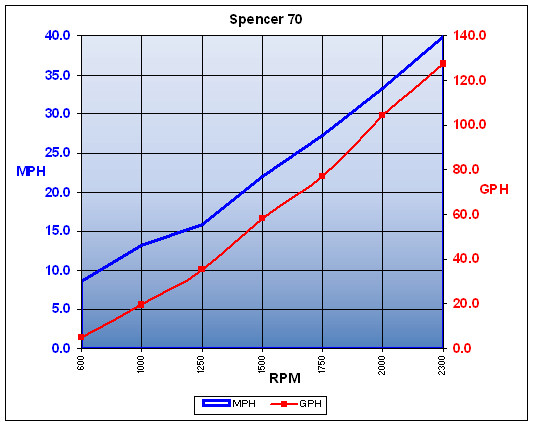
Specifications
| Length Overall | 70' 0'' / 21.3 m |
|---|---|
| Beam |
20' 3'' 6.17 m |
| Dry Weight |
83,500 lbs. 37,954 kg |
| Draft | N/A |
| Deadrise/Transom | 11 deg. |
| Max Headroom | N/A |
| Bridge Clearance | N/A |
| Fuel Capacity |
1,300 gal. 5,070 L |
| Water Capacity | N/A |
Acceleration Times & Conditions
| Time to Plane | 8.3 sec. |
|---|---|
| 0 to 30 | 18.3 sec. |
| Ratio | N/A |
| Props | N/A |
| Load | 8 persons, 1/2 fuel, 6/7 water, minimal gear |
| Climate | 85 deg., 72% humid.; wind: 5 mph; seas: calm |
Engine Options
| Tested Engine |
3 x 900-hp Volvo Penta D13 IPS1200 |
|---|---|
| Std. Power |
Not Available |
| Opt. Power |
Volvo Penta D13 |
Captain's Report
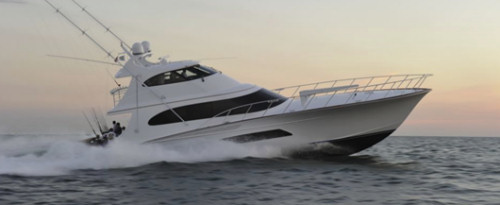
When Volvo Penta introduced its revolutionary IPS system a few years ago it knew that its pod drives and joystick system would be a natural fit for large, big game convertibles. They knew it because when gold-plated anglers have a potential record billfish hooked up, getting that thousand-pound plus monster to wire can only be done if the boat is nimble. This is a little subject that most anglers don't like to talk much about, but the fact is that when it comes to record big game fish, the maneuverability of the boat and dexterity of the skipper at the controls are as important as the strength and skill of the angler himself.
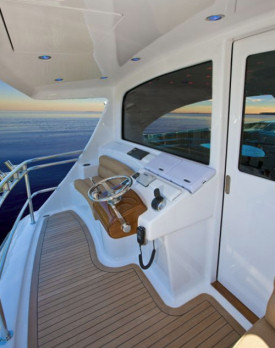
Typically, large sportfishing convertibles can weigh 100,000 lbs. (45,454 kgs.) or more. Turning and twisting them on a dime to keep the transom pointed at the action and to stay in front of a madly darting game fish hell-bent on escaping certain death is not easy. A conventional inboard boat's props are fixed and its rudders are exceedingly small because the drive system was designed to move the boat forward as fast as possible, not to bob and weave, turn on a dime, back down on the diagonal and shoot off to one side or the other in a split second. But that is exactly what anglers have been trying to do with their sportfishing boats for generations.
New Pod & Joystick Technology
The IPS drive system, on the other hand, has pods with two counter-rotating props grabbing the water and creating thrust which can be directed not only fore and aft but also 30-degrees to one side or the other independently. Its fly-by-wire control system eliminates the need for separate levers for gears and throttle so now a captain can react instantly to the shooting torpedo below. IPS was made to order for large sportfishing convertibles owned by big game anglers. Volvo Penta announced its revolutionary drive system in late 2005, but years later it had yet to be installed in a large convertible until Paul Spencer jumped on them a couple of years ago. That got everyone's attention.
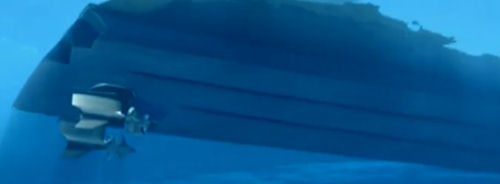
Reason for the Spencer 70 IPS
Little wonder, then, that when Volvo Penta decided to build a company boat with its new IPS system, it selected a 70' convertible rigged for big game fishing. Picking Spencer Yachts to build the boat was a natural choice because Spencer is a custom builder and its sportfishing boats are among the fastest and most revered boats on the big game tournament circuit. What's more, Paul Spencer had gained a reputation for being a traditionalist who liked to try out new technology.
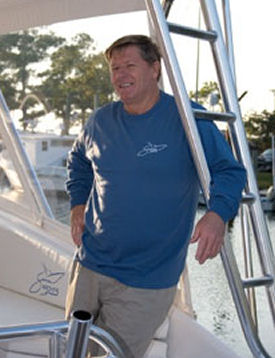
Spencer Back Story
For people growing up and living in the Outer Banks of North Carolina there is not much gainful employment. The opportunities that do exist revolve around the areas summer-time vacation visitors and residents. Serious anglers have been coming to the Outer Banks to fish the U.S. continental shelf since before WWII and have provided locals with a livelihood as charter boat captains.
As a boy of 12, Paul Spencer worked summers as a mate on charter boats taking wealthy anglers out into the Atlantic for a day of fun. Paul didn't know it at the time, but he was serving his apprenticeship. There is nothing like being the person who actually has to rig the bait on a rocking, slippery deck to appreciate some of the finer and most esoteric points of boat design and building.
For example, as a mate, Paul learned quickly the importance of things like proper location of tackle drawers with proper latches, and how vital it was to have large scuppers to quickly dewater a cockpit after backing down and scooping up 500 gallons of green water. As a wireman he understood how close he had to get to the water to bring aboard an exhausted billfish. Throughout his teen years he worked every summer on sportfishing boats and began developing his own ideas about what worked well and not so well, what was truly important to keep a fish hooked up and what caused fish to be lost.
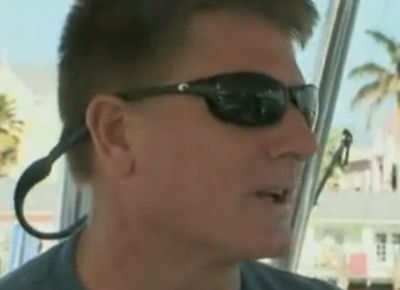
When he was 19 Paul got his captain's license. In time he got his own fishing boats and then spent seven years earning his living as a charter fishing boat captain both off the Carolina coast and in big game tournaments elsewhere in the off season. Like a number of other men on the Outer Banks, Paul's experience as a charter captain led him to boat building.
Anglers Are Not Easy to Please
As a captain, every day Paul took a party out would be a test. First he had to get his paying customers out to the fishing grounds quickly and as comfortably as possible. Next he had to find the desired game, get it hooked up, then make sure the angler was able to get the fish to wire, or aboard, without that stomach-sinking feeling when the line -- all of a sudden -- goes slack.
Along the way Paul got to know the kind of men and women who are big game anglers and who buy large convertibles. He learned what they really appreciated in a boat. He also learned that they didn't have much tolerance for things not quite right or half-baked -- nor did they like excuses. Anglers are tough customers.
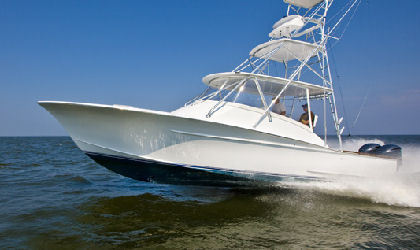
Spencer Yachts is Founded
Fourteen years working on charter boats developed some pretty firm ideas in Paul's head about how boats should be built, what their performance should be, and how their mechanical systems should be engineered and installed for ease of access and reliability. In 1996 Paul began building boats and Spencer Yachts was officially started in 1997. Since that time Spencer has completed 75 custom yachts. The largest boat finished so far was a 76-footer, but right now the yard has an 87-footer under construction. It will be the largest boat ever built in Dare County, N.C.
We would say that the rest is history except that after speaking with the 54-year-old Spencer, it becomes quite clear that he is a man who intends to make a lot more history in boat building than what we have seen so far. "I believe in modern technology and when something new comes along I want to try it out and if it works, incorporate it into my boats," Spencer told us.
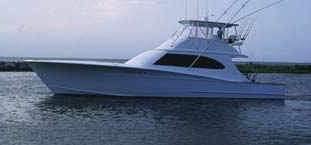
Paul's five grown and married children also work in the company, with Daniel in sales and Cliff in charge of the Wanchese yard. His three daughters work in the office. Because Spencer Yachts is truly a family affair management is close-knit and has a strong impetus to keep the customer happy and the boat-building humming along.
Paul has plans to soon roll out a new line of custom fishing boats called the "Sportsman" line. Essentially these boats will look the same on the outside as his current boats, but on the inside will have fewer amenities and luxuries, and as a result will be priced lower than his current products. Spencer is also in the final stages of completing a 25' center console powered by twin outboards. "If I like the way she performs," Paul told us, "I'll make the molds and put it into production."
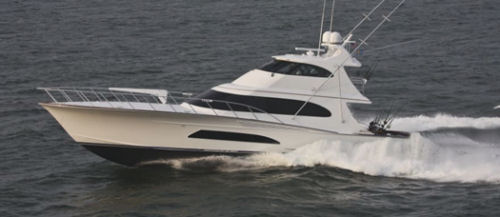
The Spencer 70 IPS
Both Spencer and Volvo Penta had their work cut out for them to produce a 70' 100,000-lb. offshore-ready convertible that could be capable of "bumping" 40 knots. The engine maker's largest marine diesel is the D13-900, which develops 900-hp at the crankshaft at 2300 rpm. Indeed, Spencer had built two other 70-footers which he had clocked at 45 knots WOT -- powered by twin 2400-hp diesels. That was 4800 total horsepower moving a nearly 50 ton boat 45 knots, so how was Spencer to do 40 knots with 900-hp diesel engines?
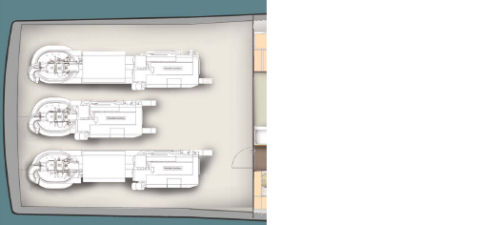
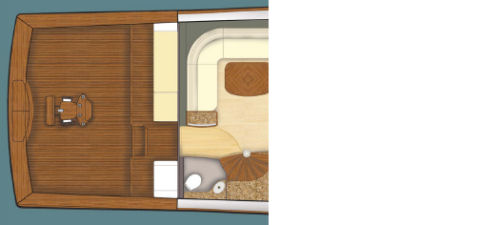
The answer was to install three D13s and use the IPS pod drives. In its testing of the IPS system before introduction, the engine maker had determined that the IPS could be counted upon to deliver fuel efficiency that was consistently 33% greater than from standard inboard drives. As a result, they decided to use an IPS designation that was 33% more than the actual horsepower of the engine. That is how the IPS1200 got its appellation. But even 3 x 1200 is only 3600-hp, so it was going to be a very close call to drive a Spencer 70 40 knots at WOT.
Because the Spencer 70 has a 20'3" (6.17 m) beam on deck and 15'9'' (4.84 m) beam at the chine, three engines would fit aboard by staggering them. The controlling dimension was actually not the beam but the depth of the cockpit and the height of the covering boards above the waterline which could not be any greater than 40" and still fit Spencer's parameters of what a good fishing boat should be.
"Some of my competition say that the covering boards should only be 36" off the water, but I like it to be anywhere from 38" to 42", depending on the length of the boat," says Paul Spencer. To Spencer's eye the sheer of a convertible must meet certain ratios given the length and height of the boat, as well as help fend off boarding water when backing down in sloppy conditions.
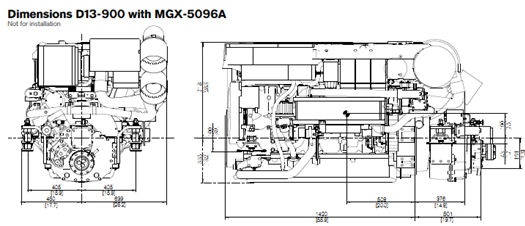
With a proper cockpit depth Spencer was able to sit the center engine in the lowest part of the hull and still have plenty of clearance over the engine. The hull thickness and strength where the three large holes for the IPS pod units would go were engineered and specified by Volvo Penta. In this way Volvo Penta could be assured that if the boat grounded at speed the lower units would break away as designed before harming the hull.
The two outboard engines which had to be higher because of the deadrise were placed further forward, under the mezzanine seating. Jack shafts connected the engines to the pods.
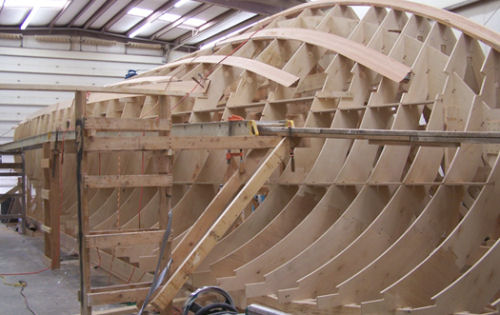
Construction Method is Key to Weight and Cost
Spencer is a custom boat builder and what makes the process efficient is the cold-molding system he uses. Traditional cold-molded boats are made with layers of thin veneer glued over an upside down jig of the hull. Spencer, however, does not use wood in the hull but rather Corecell foam which has high sheer strength and low density. This makes it ideal for hull construction because it does not soak up resin and add weight and it is easy to mold.
After the jig has been set up and planked, 1" (25.4 mm) sheets of Corecell foam (which weigh 6 lbs. per cu. ft.) are placed completely over the jig and fitted closely together. A layer of "flow medium" cloth is placed on this core and then another layer of 1" Corecell foam is fitted over it. Epoxy resin is then infused and the two layers of form core are laminated together. What follows is a more-or-less conventional layup with several layers of bi-axial E-glass and one layer of Kevlar covering the complete hull on the outside. In the keel, bottom and chine sections four or five layers of fiberglass are added, all wetted out one at a time with epoxy resin.
100% Epoxy Resin
Once the outside of the hull has been completed, the hull is turned over, the jig is taken out, and another three to five layers of fiberglass are placed in the inside and again epoxy resin is used as the bonding medium. The fact that Spencer's hulls are made of 100% epoxy resin and not a combination of a vinylester resin skin coat to stop water osmosis and polyester resin for the rest of the laminate, sets his boats apart from most production hulls. Not surprisingly, epoxy resin is the most expensive resin material used in hull laminations. And it is impervious to water osmosis.
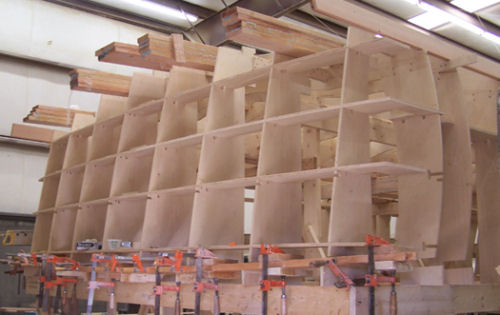
The Kevlar layer also sets Spencer hulls apart from most other convertible production hulls being built today. A couple of builders use balsa core below the waterline, or in the hull sides, or both, because end-grain balsa has more puncture resistance than does closed cell foams. But because Spencer laminates in a layer of Kevlar, his hulls are bulletproof in more ways than one.
Fairing the Hull
Once the hull is laminated, the outside then must be faired, a job that must be done by hand, as it has been done in boat yards for centuries. Fine grit sandpaper, battens as long as 20' (6 m), as well as 3' sanding blocks are used to take off the high spots, and the low spots are filled in with epoxy as they go. We asked Paul how long it took him to fair such large hulls, and we were surprised by the answers. With 20 men on the job working together, it can be done in one long day. This is essentially the same as how plugs are faired for production-boat molds.
"One of the things that keeps the amount of fairing needed down is the fact that our jigs are so precisely cut and fitted," said Spencer. All of the sections are drawn on CAD-CAM machines and cut on 5-axis routers by outside vendors. This strategy keeps overhead down and quality up.
Boat Price is the Same
When asked about the extra man hours that Spencer had to put into making the hull, deck and superstructure since all are one-offs, he said that he would far rather have these expenses than have a production boat where every boat had to come out the same. "A large convertible might need 50 molds to do it right," Spencer said. "A production boat builder needs to sell 50 boats to amortize his tooling. I can build a custom boat for about the same price as a production boat company has to charge and the customer will get exactly what he wants," he said.
What Paul didn't say was that he thinks his boats are a lot better looking than any production boat on the market. The lines of the Spencers are all drawn by Paul himself. The swooping sheer, rake of the house, and the cosmetic exterior details are all his -- as is the bottom shape. Applied Concepts takes Paul's drawings and specs and draws the boats on a CAD-CAM. Another vendor cuts out the plywood sections with a 5-axis router.

Design of the Spencer 70
Paul wants boats that go fast, are dry, seaworthy and comfortable when rushing out and back to the fishing grounds. In order to do all of those things a hull has to be fine forward and fairly flat in the stern sections.
The deadrise angle of the Spencer 70 built for Volvo Penta is 11 degrees. That is flatter than many production boats, particularly ones that have built their reputation on the deep-V or semi-V hull concept. Midships on the 70 Paul says the deadrise is about 26 degrees becoming as much as 35-degrees at the chine. Spencer says that all of his boats above 45' have a "super sharp" deadrise in the forefoot, possibly 55 degrees or so.

When it comes to big game offshore fishing tournaments, the Spencer is usually the hare that the production greyhounds are chasing. That is because Paul likes fast boats and he says his customers seem to as well. "I ask my customers how fast they want to go, 25, 35 or 45 knots," Paul says. "Then I build them a boat that can do that. If they want to go 45 knots I bring the deadrise aft. If they want to go 25 knots, I'll put as little as 8 to 9 degrees of deadrise in the bottom at the transom of a 45-footer."
The Spencer 70 for Volvo Penta was completed in 15 months, which Paul says is about as fast as he can build a boat of that size. Inside the boat was beautiful, and no expense seemed to be spared on the accommodations or fit-out.
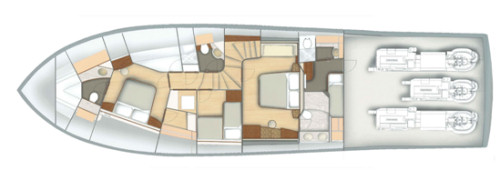
Cutting to the Chase
When it came to her speed trials, Volvo Penta insisted that the boat be tested with full fuel and water and the normal gear a fishing party would carry. As a result, the 83,500 lb. (37,954 kg.) dry weight boat soared 14,710 lbs (6,686 kgs.) to 98,210 lbs. (44,640 kgs.). Her 1,300 gallons (5,070 L) of diesel fuel alone weighted 9,360 lbs. (4,254 kgs.) There were also 10 people aboard and the ambient air temperature was 90 F, and the seas were calm.
At wide open throttle (WOT) the Spencer 70 Penta-Gone was clocked by Volvo Penta engineers at an average speed of 38.25 knots -- 44 mph. At that speed she was burning 134.12 gph (509 lph).
Her best cruise speed for fuel efficiency was 17.35 knots (20 mph) at 1400 rpm burning 44.20 gph (167.96 lph). At 1800 rpm she burned 58.09 gph (220.74 lph) and went 25.45 knots, 29.28 mph. At cruise speeds the boat was remarkably fuel efficient -- and remember she had three engines pushing around her 98,000 lbs.
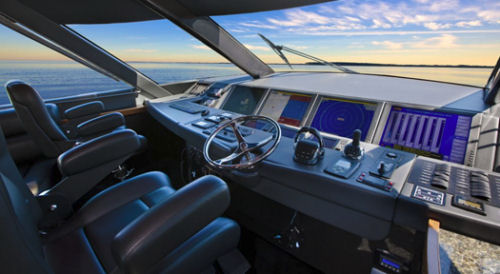
When most boats in the convertible top-speed war make their speed runs, they carry half fuel and water or even less. That 4,000 to 6,000 lbs. of absent fuel and water can easily be worth a couple of knots.
IPS Catching On Among Anglers
The last couple of years the possibilities of IPS have caught the imaginations of more and more anglers. Since there are only a few production fishboat builders using IPS, or any pod drive, anglers have been coming to Spencer and asking him to build the boat of their dreams. In the last couple of years Spencer has built two 43s, a 49, and a 57 in addition to the 70, all with IPS drives. Currently, Spencer has a 57 and a 61 under construction that will be fitted with IPS.
Setting Spencer Apart
We asked Paul Spencer why he thought his boats had such appeal to well-heeled anglers. He said the people who come to him are veterans who have been around and know what's available and what they want. "My customers want performance, speed and looks," he said.
And clearly Paul likes nothing better than a customer who wants to push the envelope. He has a laundry list of things that he does to try to get any competitive edge possible for his tournament-bound customers. For example he fits bow thruster controls right in the control sticks so the skipper can operate them with his thumbs while his hands are still on the sticks. He cleans the bottom of his boats of all possible appendages and protrusions such as transducers and raw water pick-ups, among other things. In order to make his boats as fast as possible, he has been known to apply Teflon bottom paint and have his crew dry and wet sand the bottom just like Olympic dinghy sailboat racers.
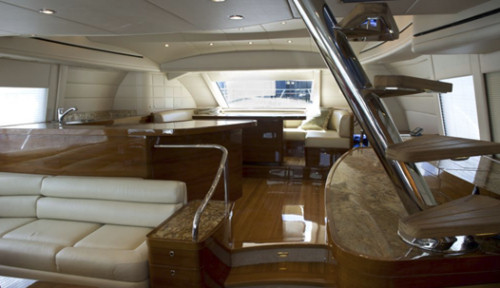
How To Commission a Spencer Yacht
We asked Paul how building a custom boat for a client typically works. He told us that first he sits down with the customer and asks what the angler wants in a boat. "For example," Paul said, "if the customer wants a convertible with four staterooms, I tell him he needs to have a 66-footer to do that right." Not surprisingly Spencer has built several boats that are exactly 66' long.
"I ask them how fast they want to go. I'll build boats that go anywhere from 25 knots to 45 knots," Spencer said. Once the speed, interior and equipment have been agreed upon Spencer asks for a $150,000 deposit, then bills the client monthly for the work that has been completed on a "cost plus basis."
How does he know what the cost of materials and labor is that goes into each boat? "We have a very efficient accounting department," Paul said. "We know every screw and bolt that goes into a boat and how much it costs. Each month we send the client the list of bills of materials and labor, plus our 15% fee."
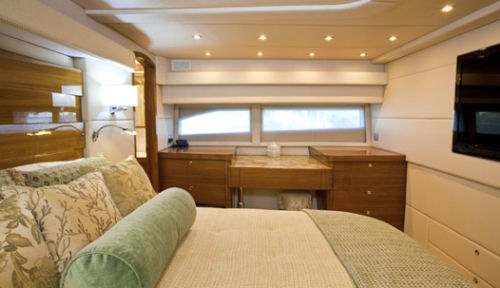
It couldn't be simpler. And, it couldn't be better for the customer because with the bills of materials and labor invoices, customers of Spencer are paying as they go and as the boat is being built. This way customers know that the money they are paying isn't building the last guy's boat, a common problem with boat builders who get into trouble. This system keeps both the boat builder and the customer honest. Spencer tells us that it generally takes about 18 to 20 months to get a large convertible completed.
And is there a "hold back" until after the sea trial? Spencer told us that usually there is a 2 month delay in the billing at the end, so everyone is happy before the last payment is made. Spencer told us that he gives every boat he builds a one year "stem to stern warranty." Depending on the arrangement with the engine maker there may be an even longer warranty on that equipment.
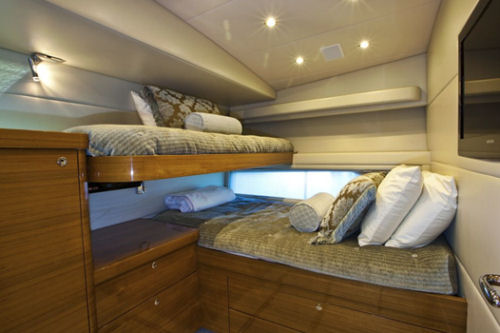
A Rude Question
We asked Paul Spencer an unpleasant question: How does a customer know that he is not going to go out of business as so many custom boat builders have before, even in good times? (That was not a very nice subject to bring up, but one that is on every potential customer's mind, so we asked it.)
We liked Paul's answer: "I own the land, the buildings, and all of the equipment in them," he said. "And I have pretty much zero debt and I like to keep it that way."
Based on our observations over 42 years in the boat business, Paul Spencer is following the magic formula to avoiding business disaster: no debt, pay as you go, keep meticulous track of the materials and labor going into each boat, sub-contract those things that require high capital expenditures (like 5-axis routers and CAD-CAM), keep overhead low, and make sure there is a profit on each unit. And, of course, give the customer what he wants.
